![]()
![]()
![]()
Use LEFT and RIGHT arrow keys to navigate between flashcards;
Use UP and DOWN arrow keys to flip the card;
H to show hint;
A reads text to speech;
80 Cards in this Set
- Front
- Back
|
Membrane-bound organelles |
-Contents are separated from cytosol -Include endoplasmic reticulum, golgi apparatus, lysosomes, peroxisomes, mitochondria |
|
|
Nonmembrane-bound organelles |
-Contents are in direct contact with cytosol -Include ribosomes, cytoskeleton, centrosomes, centrioles, cilia, flagella, and microvilli |
|
|
What is the Endoplasmic reticulum (ER)? |
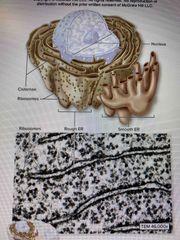
The endoplasmic reticulum is an intracellular membrane network |
|
|
What are the two regions of the Endoplasmic reticulum? |
Smooth endoplasmic reticulum and rough endoplasmic reticulum |
|
|
Function of the smooth endoplasmic reticulum? |
-Synthesis, transport, and storage of lipids including steroid hormones -Metabolism of carbohydrates -Detoxification of drugs, alcohol, and poisons |
|
|
Smooth Endoplasmic Reticulum Structure |
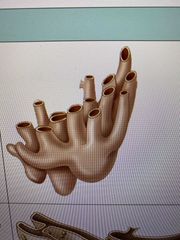
-Is smooth in appearance due to lack of ribosomes -Resembles interconnected branches of tubules -Continuous with rough endoplasmic reticulum |
|
|
Rough Endoplasmic Reticulum Structure |
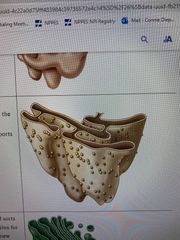
-Rough in appearance due to presence of associated ribosomes -Consists of parallel membranes enclosing spaces called cisternae Rough Endoplasmic reticulum receives newly synthesized proteins from ribosomes |
|
|
Rough Endoplasmic Reticulum Function? |
-Proteins will be secreted, inserted into plasma membrane or included in a lysosome -Rough Endoplasmic reticulum modifies the proteins and package them into transport vesicles (Vesicles moved to Golgi apparatus) -Cells that perform lots of secretion (e.g., pancreas cells have lots of RER and extensive Golgi apparatus) |
|
|
Golgi Apparatus (Golgi Complex) |
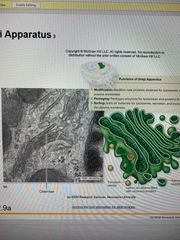
-Receives material from the Endoplasmic reticulum for modification, sorting, and packaging -Consists of stacked cisternae -Lateral edges bulge, pinch off, and give rise to small transport and secretory vesicles |
|
|
What are the two polarities for the Golgi Apparatus? |
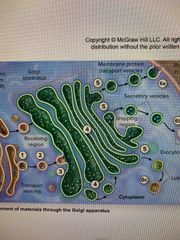
-Receiving region is the cis-face -Shipping region is the trans-face |
|
|
What is the lysosome? |
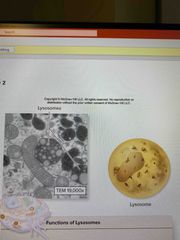
-Lysosomes are membranes sacs generated by Golgi apparatus -Contains enzymes used to digest and remove waste products and damaged organelles within the cell (autophagy) -When a cell is dying, it releases lysosomal enzymes that digest the cell (autolysis) |
|
|
What is the Peroxisomes? |
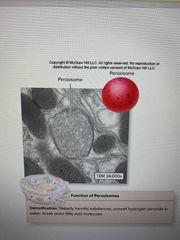
-Peroxisomes are membrane-enclosed sacs formed by pinching off the rough Endoplasmic reticulum -Smaller than lysosomes -Use O2 and catalase to detoxify harmful molecules in cell -Abundant in liver cells |
|
|
Mitochondria |
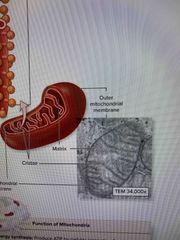
Are organelles with a double membrane involved in producing ATP to drive cellular reactions |
|
|
Mitochondria |
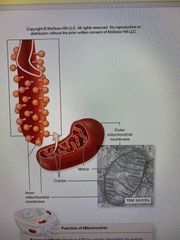
Are organelles with a double membrane involved in producing ATP to drive cellular reactions |
|
|
Structure of the mitochondria |

-Double membrane -Inner membrane folded into shelf-like cristae -Internal fluid called matrix -Containa fragment of DNA with genes for mitochondrial proteins *Cells that require more energy (e.g., muscle cells) have more mitochondria) |
|
|
Ribosomes |

Ribosomes are nonmembrane-bound organelles responsible for protein synthesis |
|
|
What are the large and small subunits for the ribosomes? |
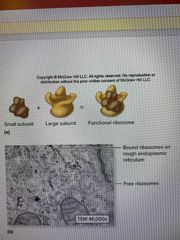
-Free Ribosomes: Float in the cytosol -Bound ribosomes: Are attached to rough Endoplasmic reticulum |
|
|
Protein synthesis for free ribosomes |
For use within the cell |
|
|
Protein synthesis for free (floating) ribosomes |
For use within the cell |
|
|
Protein synthesis for bound (attached) ribosomes |
Synthesize proteins destined to be incorporated into the plasma membrane, exported from the cell, or housed within lysosomes |
|
|
Cytoskeleton |

The cytoskeleton is a network of proteins organized as solid filaments or hollow tubes |
|
|
Cytoskeleton |
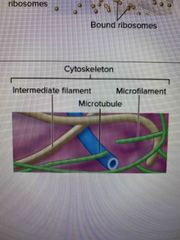
The cytoskeleton is a network of proteins organized as solid filaments or hollow tubes |
|
|
What are the three cytoskeletal components? |
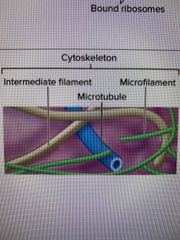
-Microfilaments -Intermediate Filaments -Microtubules |
|
|
What is the function of the cytoskeleton? |
Provides structural support; facilitates cytoplasmic streaming, organelle and cellular motility, transport of materials, chromosomal movement and cell division |
|
|
Microfilaments |
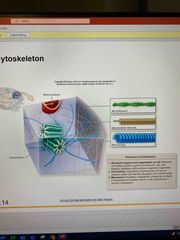
Structure: Actin protein monomers formed into filaments Function: Maintain cell shape; aid in muscle contraction and intracellular movement; separate dividing cells |
|
|
Intermediate filaments |
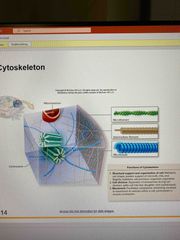
Structure: Various protein components Function: Provide structural support; stabilize cell junctions |
|
|
Microtubules |
Structure: Hollow cylinders of tubulin protein; able to lengthen and shorten Function: Support cell; hold organelles in place; maintain cell shape and rigidity; direct organelle movement within cell and cell motility as cilia and flagella; move chromosomes at cell division |
|
|
Microtubules |
Structure: Hollow cylinders of tubulin protein; able to lengthen and shorten (not permanent structure) Function: Support cell; hold organelles in place; maintain cell shape and rigidity; direct organelle movement within cell and cell motility as cilia and flagella; move chromosomes at cell division |
|
|
Microtubules |

Structure: Hollow cylinders of tubulin protein; able to lengthen and shorten (not permanent structure) Function: Support cell; hold organelles in place; maintain cell shape and rigidity; direct organelle movement within cell and cell motility as cilia and flagella; move chromosomes at cell division |
|
|
Centrosome |
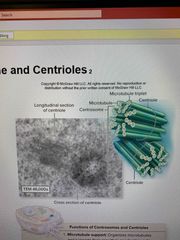
-Nonmembraneous, spherical structure adjacent to nucleus -Contains pair of centrioles at right angles to each other |
|
|
Centrosome Function |
Organizes Microtubules; participates in spindle formation during cell division |
|
|
Centrioles |
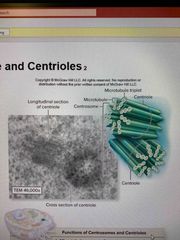
-Each centriole contains nine sets of microtubule triplets -Involved in organizing microtubules -Attached to chromosomes during cell division causing chromosomal migration |
|
|
Cilia and Flagella |
-Projections extending from cell -Contain cytoplasm and supporting microtubules, enclosed by plasma membrane |
|
|
Cilia |
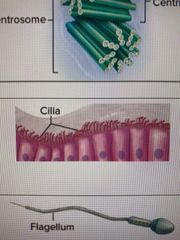
Structure: On exposed surfaces of certain cells; move objects across their surface (ex: cells of respiratory passages use cilia to move mucus) Function: Move fluids, mucus, and materials over the cell surface |
|
|
Flagella |
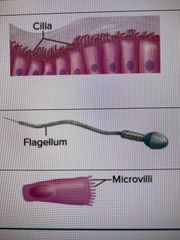
-Longer than cilia, and usually singular; used to propel a cell (Ex: Sperm) |
|
|
Flagella |
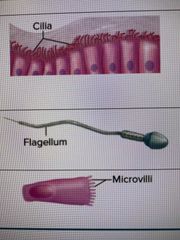
Structure & Function: Longer than cilia, and usually singular; used to propel a cell (Ex: Sperm) |
|
|
Microvilli |

Structure: Thin, microscopic projections extending from the plasma membrane. Smaller and more densely packed than cilia, and not capable of motion Function: To increase surface area of plasma membrane for enhanced membrane transport (Ex: in small intestine, increase absorption of nutrients) |
|
|
Plasma (cell) membrane |

Structure: Phospholipid bilayer containing cholesterol, proteins (integral and peripheral), and some carbohydrates (externally) Function: Contains receptors for communication; forms intercellular connections; acts as physical barrier (think of a sandwich) to enclose cell contents; regulates material movement into and out of the cell |
|
|
Cytoplasm |
Structure: Contains cytosol (a viscous fluid), inclusions, and organelles Function: Place of many metabolic processes of the cell; stores nutrients and dissolved solutes |
|
|
Cytoplasm |

Structure: Contains cytosol (a viscous fluid), inclusions, and organelles Function: Place of many metabolic processes of the cell; stores nutrients and dissolved solutes |
|
|
Cytosol |
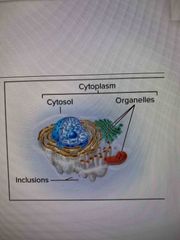
Structure: Viscous fluid medium with dissolved solutes (ions, nutrients, proteins, carbohydrates, lipids, and other small molecules) Function: Provides support for organelles; serve as viscous medium through which diffusion occurs |
|
|
Inclusions |
Structure: Droplets of melanin, protein, glycogen granules, or lipid; usually non membrane-bound Function: store materials (e.g., glycogen in muscle cells; triglycerides in fat cells) |
|
|
Inclusions |

Structure: Droplets of melanin, protein, glycogen granules, or lipid; usually non membrane-bound Function: store materials (e.g., glycogen in muscle cells; triglycerides in fat cells) |
|
|
Nucleus |

-Three main parts: nuclear envelope, nucleoli, chromatin Structure: Surrounded by double membrane nuclear envelope (each membrane is a phospholipid bilayer); contains nucleolus and chromatin within nucleoplasm (a fluid) Function: Acts as cell control center; houses genetic information (DNA); site of ribosome subunit assembly |
|
|
Nuclear Envelope |
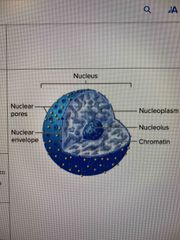
Structure: Double membrane boundary between cytoplasm and nuclear contents Function: Physical barrier that controls movement of materials between the nucleus and the cytoplasm |
|
|
Nucleoplasm |
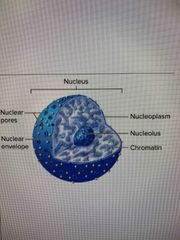
Structure: Fluid or semi fluid medium housed in the nucleus Function: Houses dissolved solutes including nucleotides and proteins |
|
|
Nuclear pores |
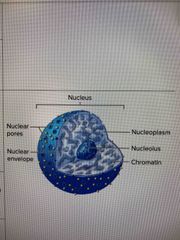
Structure: Openings through the nuclear envelope Function: Allow for passage of materials between nucleus and cytoplasm |
|
|
Nucleolus (Or Nucleoli) |
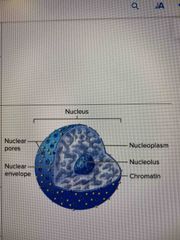
Structure: Spherical, dark-staining, dense granular region in the nucleus Function: Synthesizes rRNA and assembles ribosomes in the nucleus |
|
|
Chromatin and chromosomes |
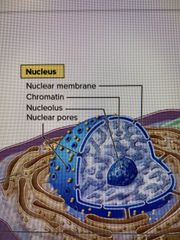
Structure: Filamentous association of DNA and histone proteins Function: Site of genes in the DNA |
|
|
What is the composition of cell membrane? |
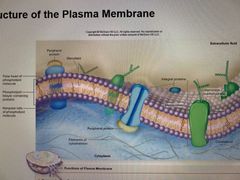
The plasma membrane and membranes within the cell are primarily composed of lipids and proteins -Lipids (Phospholipids, Cholesterol, Glycolipids) -Proteins (Integral, Peripheral) |
|
|
Role of lipid and carbohydrates in the cell membrane |
Phospholipid-think of a balloon with two tails. Charged polar head which is hydrophilic (water loving or interacts well with water) vs two tails that are non polar and hydrophobic (water hating or repelled by water). The tails form the internal environment of the membrane, which is hydrophobic and keeps charged particles from crossing the membrane. It keeps the intracellular fluid inside the cell and the extra cellular fluid outside of the cell Cholesterol: About 20% of membrane lipids. Role is to strengthen and stabilize membrane against extreme temperature Glycolipids: About 5%-10% of membrane lipids. They also have carbohydrates groups attached. They are located on the outer layer of the membrane where they are exposed to extracellular fluid. The carbohydrate portion of the Glycolipid molecule is a component of the glycocalyx, which functions in cell-cell recognition, intracellular adhesion, and communication. |
|
|
Role of proteins in the cell membrane |
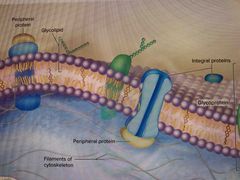
Integral proteins: -Span entire membrane -Some are membrane channels, allowing specific substances to pass -Some are receptors that bind to external molecules -May have carbohydrates attached=glycoproteins Peripheral proteins: -Loosely attached to membrane *Both integral and peripheral proteins may act as enzymes. Enzymes are molecules that are important for functional or metabolic activities in the cell because they change the rate of reaction without being affected by the reaction itself |
|
|
Nucleotides in DNA |

(T) Thymine (A) Adenine (C) Cytosine (G) Guanine |
|
|
Transport (Protein-Specific Functions of the Plasma Membrane) |
Movement of material across the membrane may require ATP (adenosine triphosphate) for energy |
|
|
Intercellular connection (Protein-Specific Functions of the Plasma Membrane) |
Protein junctions between some cells |
|
|
Anchorage for the cytoskeleton (Protein-Specific Functions of the Plasma Membrane) |
Cell shape maintained by proteins |
|
|
Enzyme (catalytic) activity (Protein-Specific Functions of the Plasma Membrane) |
Affect the rate of chemical reactions: example=ion pumps moving ions across the membrane |
|
|
Cell-cell recognition (Protein-Specific Functions of the Plasma Membrane) |
Glycoproteins aid in cell identification |
|
|
Signal Transduction (Protein-Specific Functions of the Plasma Membrane) |
Transmission of a chemical message outside the cell to inside the cell |
|
|
Which phase is shortest in cell division? |
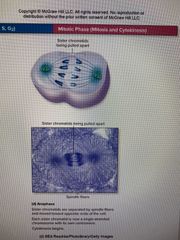
Anaphase |
|
|
What is cleavage furrow? |
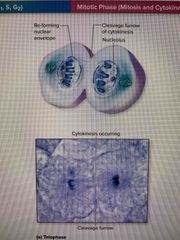
Seen in Telophase Appears as cytoplasm divides |
|
|
What means cytokinesis? |
In the Mitotic Phase-produces two daughter cells that are genetically identical to the original (parent) cell Cytokinesis: division of the cytoplasm |
|
|
What means mitosis? |
In the Mitotic Phase-produces two daughter cells that are genetically identical to the original (parent) cell Mitosis: division of the nucleus Mitotic stages: Prophase, Metaphase, Anaphase, and Telophase |
|
|
Cell cycle (Interphase & Mitotic) |
Somatic (body) cells divide through a process called mitosis, that produce two daughter cells that are identical to the original, or parent cell. The set of events that occur in the cell leading up to and including mitosis is called the cell cycle. (Interphase-G1, S, G2, M phase) |
|
|
What is the G1 phase? |
Growth and preparation for DNA replication |
|
|
What is S Phase? |
DNA replication |
|
|
What is the G2 Phase? |
Growth and preparation for division of DNA |
|
|
What means mitosis? |
Division of nucleus |
|
|
What is an interphase? |
Interphase is a time when the cell carries on its normal activities and prepares for divisions. Interphase is a time for growth and making new cellular parts, replicating DNA and centrioles, and producing the proteins, RNA, and organelles needed for cell division |
|
|
Necrosis (cell death) |
They are killed by harmful agents or mechanical damage. The damage is irreversible and there is an inflammatory response |
|
|
Apoptosis (cell death) |
Programmed cell death; important during development and to remove unhealthy cells They are induced to commit suicide. Cells in apoptosis exhibit nuclear changes (chromatin degradation), shrinkage in volume, and abnormal development in both organelle and plasma membrane structure. |
|
|
Describe the effects of aging on the cell |
Reduced metabolic function can decrease the ability to maintain homeostasis. Affected cells may exhibit alteration in either the structure or the number of specific organelles |
|
|
Neoplasm |
Tumor |
|
|
Benign Neoplasm |
Grow slowly and are confined within a connective tissue capsule. These tumors are usually not lethal, but they have to the potential to become life-threatening if they compress brain tissue, nerves, blood vessels, or airways |
|
|
Malignant Neoplams |
Are unencapsulated, contain cells that dedifferentiate, increase their vascular supply, grow rapidly, and are able to spread easily to other organs by way of the blood or lymph, and phenomenon called metastasis |
|
|
Passive Transport |
Across the membrane does NOT require energy, and instead relies on concentration gradients. Substances will naturally travel from high to low concentrations to reach equilibrium, which is the absence of a concentration gradient. This means the concentrations on either side of the membrane are equal |
|
|
Active transport |
Requires energy, because it moves substances against their concentration gradient, or from low to high concentration |
|
|
Osmosis |
Specifically refers to the movement of water |
|
|
Osmosis |
Specifically refers to the movement of water |
|
|
Diffusion |
Is the movement of substances towards equilibrium |

